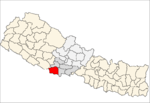Taulihawa, Nepal
Taulihawa[1], also known as Kapilavastu, is one of the oldest municipality and administrative center of Kapilvastu District in Province No. 5 of southern Nepal. Taulihawa is located roughly 25 kilometres (16 mi) to the south-west of Lumbini, a UNESCO World Heritage Site and the birthplace of Gautama Buddha.[2][3]
Taulihawa तौलिहवा | |
|---|---|
Entrance gate to Taulihawa, Kapilvastu District, Nepal | |
 Taulihawa Location in Nepal | |
| Coordinates: 27°32′N 83°3′E | |
| Country | |
| Zone | Lumbini Zone |
| District | Kapilvastu District |
| Government | |
| • Mayor | Kiran Singh (NC) |
| • Deputy Mayor | Laxmi Kasaudhan (NC) |
| Elevation | 107 m (351 ft) |
| Population (2011 A.D) | |
| • Total | 30,428 |
| Time zone | UTC+5:45 (NST) |
| Postal code | 32800 |
| Area code(s) | 076 |
| Website | kapilvastumun |
| Pilgrimage to |
| Buddha's Holy Sites |
|---|
 |
| The Four Main Sites |
| Four Additional Sites |
| Other Sites |
|
| Later Sites |
|
The municipality lies at an altitude of 107 metres (351 ft) above sea level[4] on Nepal's southern border across from Uttar Pradesh state, India. There is a customs checkpoint for goods while movement of Indian and Nepalese nationals across the border is unrestricted. Taulihawa had a population of 27,170 at the time of the 2001 Nepal census.
History
Many historians claim Tilaurakot located in Kapilavastu municipality (Taulihawa) to be the ancient city of Kapilavastu. On the other hand, some other archaeologists have identified present-day Piprahwa, India as the location for the historical site of Kapilavastu. [5][6] The 19th-century search for the historical site of Kapilavastu followed the accounts left by Faxian and later by Xuanzang, who were Chinese Buddhist monks who made early pilgrimages to the site.[7][8][9][10] Kapilavastu was an ancient city and the capital city of the Shakya kingdom. King Śuddhodana and Queen Māyā are believed to have lived at Kapilavastu, as did their son Prince Siddartha Gautama until he left the palace at the age of 29.[11]
Historical sites
There are many sites of historical interest in or very close to Kapilavastu, including:
- Amaulikot
- Arourakot Darbar
- Bardahawa
- Bargadawa Stupa
- Bikulikot
- Derwa Stupa
- Dohanikot
- Gotihawa, birthplace of Kakusandha Buddha, marked by an Ashoka pillar
- Jagdishpur Reservoir
- Kanthak Stupa
- Kapilvastu Museum
- Kopawa Stupa
- Nigrodharama, the ruins of a Buddhist monastery where Gautama Buddha is believed to have stayed when visiting Kapilavastu
- Lohasariya Stupa
- Lumbini, the birthplace of Gautama Buddha
- Nigali Sagar, an archeological site in Nigalihawa, birthplace of Koṇāgamana Buddha, marked by an Ashoka pillar
- Paltimai Temple
- Pipara Stupa
- Pipari
- Piprahwa, a village and archaeological site in Siddharthnagar district, Uttar Pradesh, India that may be one of the burial sites of a portion of the ashes of Gautama Buddha
- Premnagar Stupa
- Ramagrama stupa, believed to be the only intact and original stupa containing relics of Lord Buddha[12]
- Rampur Siddhipur Stupa
- Sagarahawa Reservoir
- Sarkup Pokhari
- Semara Shiv Mandir
- Sihokhor Stupa
- Siseniya Stupa
- Tauleshwor Nath Mandir (Shree Tauleshwor Nath Mandir) is a devotional temple for Hindus. Many Hindus come here to worship Lord Shiva during the Maha Shivaratri festival.[13]
- Tilaurakot
- Twin Stupa
See also
Notes
- http://www.myrepublica.com/news/10568
- UNESCO World Heritage Centre. "UNESCO World Heritage Centre - World Heritage Committee Inscribes 46 New Sites on World Heritage List". unesco.org. Retrieved 24 April 2015.
- "Lumbini, the Birthplace of the Lord Buddha". UNESCO. Retrieved 1 March 2011.
- "Taulihawa". fallingrain.com. Retrieved 24 April 2015.
- Tuladhar, Swoyambhu D. (November 2002), "The Ancient City of Kapilvastu - Revisited" (PDF), Ancient Nepal (151): 1–7
- Chris Hellier (March 2001). "Competing Claims on Buddha's Hometown". Archaeology. Retrieved 21 March 2011.
- Beal, Samuel (1884). Si-Yu-Ki: Buddhist Records of the Western World, by Hiuen Tsiang. 2 vols. Translated by Samuel Beal. London. 1884. Reprint: Delhi. Oriental Books Reprint Corporation. 1969. Volume 1
- Beal, Samuel (1911). The Life of Hiuen-Tsiang. Translated from the Chinese of Shaman (monk) Hwui Li by Samuel Beal. London. 1911. Reprint Munshiram Manoharlal, New Delhi. 1973. Internet Archive
- Li, Rongxi (translator) (1995). The Great Tang Dynasty Record of the Western Regions. Numata Center for Buddhist Translation and Research. Berkeley, California. ISBN 1-886439-02-8
- Watters, Thomas (1904). On Yuan Chwang's Travels in India, 629-645 A.D. Volume1. Royal Asiatic Society, London.
- Trainor, K (2010). "Kapilavastu". In Keown, D; Prebish, CS (eds.). Encyclopedia of Buddhism. Milton Park, UK: Routledge. pp. 436–7. ISBN 978-0-415-55624-8.
- UNESCO (2014). "Ramagrama, the relic stupa of Lord Buddha". Tentative Lists. Paris: UNESCO World Heritage Centre. Retrieved 2014-11-30.
- "Nepal Census 2001". Nepal's Village Development Committees. Digital Himalaya. Archived from the original on 12 October 2008. Retrieved 14 December 2008.
External links
- Lumbini On Trial: The Untold Story by Terry Phelps. See Section 'The Kapilavastu of the Chinese Pilgrims' and following passage also.
| Wikimedia Commons has media related to Kapilavastu. |
- Description of Kapilavastu by the Chinese pilgrim monk Faxian (399-414 AC)
- Suttas spoken by Gautama Buddha concerning Kapilavatthu: (more)
- Cula-dukkhakkhandha Sutta - The Lesser Mass of Stress
- Sakka Sutta - To the Sakyans (on the Uposatha)''
